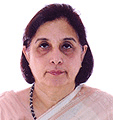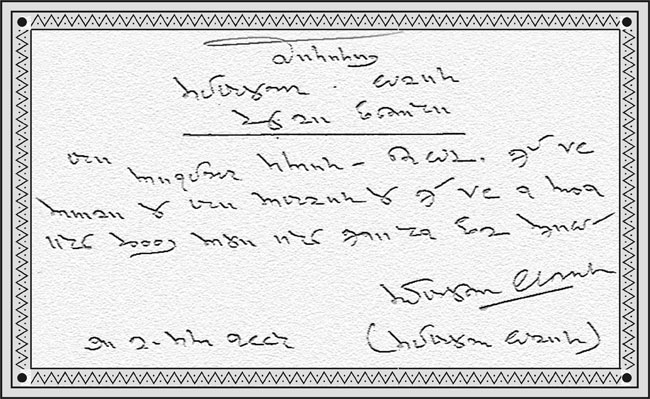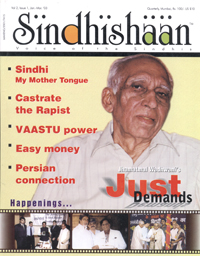Shikarpuris Blazed the Track of
Money-Lending Industry
By Dr. (Ms) Subhadra Anand

Money-lending or Banking is the most powerful industry in the world, and the Sindhis were the pioneers of this tricky but lucrative business of money lending since undivided India. Principal Dr. (Ms.) Shubhadra Anand of prestigious National College of Arts, Science & Commerce at Bandra, Mumbai, traces for SINDHISHAAN the role of Shikarpuris in the money-lending trade which has today become one of the most powerful industries in the world.

Money lending and banking has been a distinctive occupational trait of the Sindhis, specially the Shikarpuris. The existence of this informal indigenous credit system has been known from time immemorial. References to it were made in the Vedas and the Buddhist Jatakas (7th–2nd Century B.C.). The Guilds were known in ancient India and were the premier organisation of credit management extending money on interest to its members. In the Mogul period, the contemporary records have shown that bankers managed the financial affairs of the state and gave long-term loans for trade. Sind being the first province to come under the Muslim rule, in 712 A.D., the credit pattern started developing on community lines. Since the Muslims were forbidden by the tenets of Islam from living off interest the inancial credit business was left in the hands of the Hindus, chief amongst whom were the Multani Shroffs whose headquarters were in Shikarpur and who came to be known as Shikarpuris.
Aitken, E.H., writing in the Gazetteer of the Province of Sind, in 1980 states “The Hindu portion of the community is in the minority as regards numbers but, as elsewhere, give their wholehearted attention to trade and commerce. Their influence in this respect is at Shikarpur where the credit system may be said to be wholly in their hand. Money transactions in the form of Hundis and promissory notes with the rest of India and many parts of the world are on a most extensive scale. They are hence very wealthy men”. In 1929 the British government decided to formalise the money-lending network under the Bombay Presidency Bank enquiry and as many as 50 bankers from Shikarpur were listed on their records as having vast international credit networks. The document further states that the integrity of the bankers from Shikarpur and Karachi was unquestionable.
Credit markets developed almost in every case where extensive long-range trade or manufacture involving stocks and consumer credit exist. Those with surplus funds lend them to those who need funds to carry on their business; first for working capital and then for fixed assets as well. Soon intermediaries grow up which develop financial instruments, which serve to reconcile the different terms (length of credit, type of security and so forth) desired by lenders and borrowers. After a period, government attempts to regulate some of these intermediaries and instruments in order to “protect all market participants and often to direct funds preferentially in one direction or other. Other intermediaries and instruments remain outside the regulatory net in the informal market”. The traditional informal market intermediaries were organised along the lines of ethnic communities. The Shikarpuries, the Gujaraties, the Chettiars, the Rastogis and so forth all have separate networks with separate if similar procedures.
The large group of Shikarpuri financiers in Bombay and South India are the most widely known of those financiers. Originally indigenous bankers of the classic sort, they largely rely on their own funds. The amount of bank funds made available to them is less than 1/10 of what it was in 1960. In a study conducted by Thomas Timberg, on behalf of the World Bank in 1980, there are roughly 600 firms which belong to the various local Shikarpuri Banker’s Association, with Rs.600 crores of capital according to one estimate. The Shikarpuris traditionally took what were known as Multani Hundis, - 90 day term notes in amounts between Rs. 3,000 and Rs. 5,000 and discounted these notes. With the decline of discount facilities they have moved towards demand promissory notes and instalment finance.
Typically, a broker will arrange to break up a large loan into smaller notes, which he will sell, to a whole group of bankers; risks are thus spread throughout the Shikarpuri community. The brokers used by Shikarpuri financiers (accounting for almost all transactions in Bombay and 75% in Madras, but very little in the smaller centres) often receive as high as 2% commission. There are 85 association member brokers in Madras and three times as much in Bombay as well as many unregistered ones. Some of these brokers (members and non-members) deal with both Shikarpuri and non-Shikarpuri funds sources. Shikarpuri lending, particularly on instalment basis, is now often done by the instrument of a post-dated cheque.
One characteristic of some of these informal credit markets worthy of note is their organisation for self-regulation. About half the Shikarpuri financiers belong to local association which serve both as social centres and enable their members to be eligible for bank re-finance. These usually do not have explicit disciplinary functions though they may exercise informal control. The bulk of informal lending goes to finance trade and industry. The Shikarpuris loan to a wide variety of small and occasionally large enterprises. Madras Shikarpuri bankers themselves mention construction, leather tanneries, cashew nuts, governments and forest contractors, hotel and restaurant owners, bidi and tobacco merchants and seafood exporters among their numerous clientele. Engineering, chemical and pharmaceuticals are the areas for Bombay Shikarpuris.
Informal money is in fact generally only available for working capital purposes because new ventures are seen to be too risky. The working capital needs that are financed are typically for advances to trade and manufacturers, large and small, who demand cash payments. The advantage of the informal sector for the borrower is the rapidity with which it can procure money. It is generally provided without having to fill up forms or spend much time in trying to fulfil regulations. In these respects, its costs to the borrower are not higher than the amount of time and money he spends in trying to get loans from an organised bank. A recent RBI study shows that 28% of firms with bank credit, report using non-institutional finance and the Shikarpuri bankers state that almost every sizeable firm in Bombay comes into their market at sometime or other.
Though some informal markets may be on the decline, due in part to explicit restrictive government actions, they still perform an important role in providing finance to trade and industry. Others expand in response to new needs of growing trade and industry. Today these needs are based on liberalisation and an open economy. Being always alert to opportunity, the Sindhis are collectively pooling in their resources, expertise and enterprise to bring together the 45 million-strong Sindhi community all over the world onto a common platform – the IndusInd. The IndusInd bank is the manifestation of the traditional traits of money lending and banking of this affluent community. The bank seeks to streamline the functioning and reduce the laborious bank formalities so as to encourage young entrepreneur and at the same time contribute towards the socio-economic development of the country.


